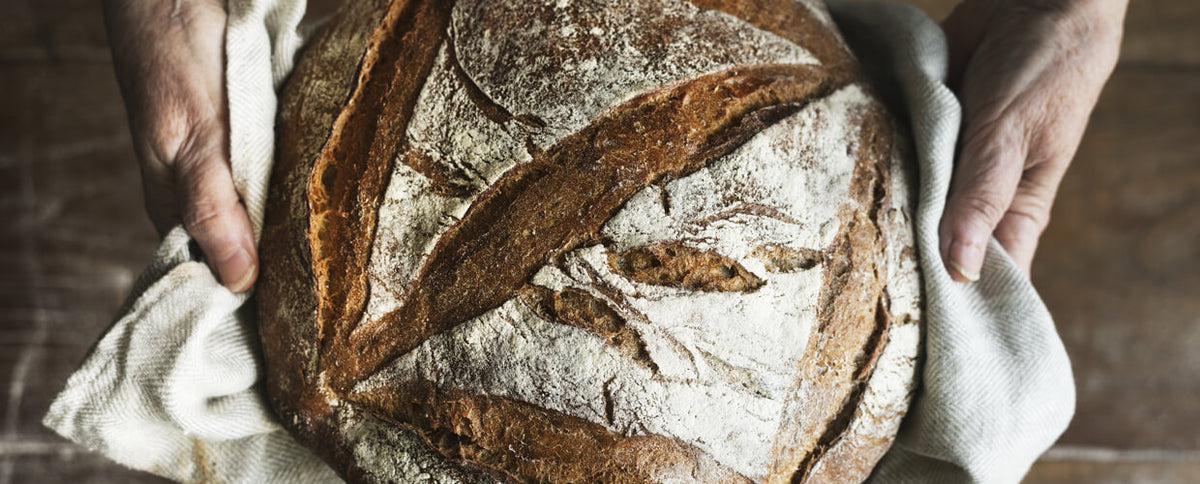Why Sourdough Bread Is Way Healthier Than "Sourfaux"

Given the anti-carb sentiment pervading much of the conversation about healthy eating these days, the term “sourfaux bread” might at first sound like a good thing; some valiant sourdough bread substitute free from the gluten or carbohydrates currently in the hot seat.
Don’t get too excited just yet, though. Turns out this spin on sourdough not only packs all of the gluten and carbs of your traditional loaf, but also contains some other ingredients you might be better off avoiding—especially if you have certain food sensitivities or digestive issues.
What’s the deal with this bread imposter? We asked the experts, so you can pick the bread that best supports your health the next time you do stop into that bakery.
Sourdough vs. Sourfaux: What’s the Difference?
Traditional sourdough bread is made with just three ingredients: flour, water, and salt.
First, bakers combine the flour and water to create what’s known as a leavening agent (or “culture” or “starter”), which helps the dough ferment and rise. While other breads use commercial yeast to make the dough rise, sourdough skips it.
“To start a sourdough bread culture, you mix flour and water together and leave it on the counter for up to a week to ferment, and it absorbs the bacteria and yeast from the environment,” explains Esther (Essie) Schultz, founder of the Good Grain Bread Company, a micro-bakery dedicated to sourdoughs. “It goes through this long, incredible process of breaking down the grain.”
“Sourfaux” bread, meanwhile, refers to bread labeled or advertised as “sourdough” but made with ingredients beyond the traditional three, including not only commercial yeast, but things like ascorbic acid, yogurt, and vinegar, too.
The appeal of this knock-off sourdough bread? “Bread rises faster with commercial yeast,” says Schultz. “You can go from dough to loaf within a few hours.”
Of course, this reduced prep time is pretty darn enticing to large grocery store chains and fast food restaurants that sell bread in bulk. The result: Many pass off “sourfaux” as the real deal.
Wondering why a little yeast and a few extra ingredients in your bread really matter? While the price tag on a loaf of mass-produced “sourfaux” may be lower than that on a traditional, artisanal bakery loaf, you get what you pay for.
5 Reasons To Eat Real Sourdough Bread
Settle for sourfaux over true sourdough bread and you miss out on a number of the classic loaf’s notable benefits.
1. It’s easier to digest
The proofing (a.k.a. final rising) process of naturally-leavened bread, like sourdough, takes several days—and it’s during that extended fermentation that the magic happens, says Kayleen St. John, M.S., R.D., adjunct professor of nutrition and food studies at New York University.
Related: Why Endurance Athletes Should Care About Probiotics
“A pre-digestion occurs, meaning the yeast and bacteria start to break down some of the chemical bonds in the flour’s starches,” St. John explains. “This makes it easier for our stomach to digest because the bacteria already did the work for us on the kitchen counter.”
2. It offers more nutritional value
Sourdough’s longer fermentation process also breaks down the phytic acids in the flour, adds St. John. Known as anti-nutrients, these phytic acids can block our absorption of certain nutrients, like minerals and B vitamins. So, eat traditional sourdough bread and you’ll get more nutritional bang for your bite.
3. It’s less likely to leave you bloated or gassy
Though our bodies struggle to digest fiber, our gut bacteria thrive on it.
Issue is, as these helpful gut bugs ferment the carbs we can’t break down, they produce gasses like hydrogen, carbon dioxide, and methane—all of which contribute to bloat and flatulence.
“However, with naturally-leavened bread, less fermentation happens in your gut because it’s already happened before the bread entered your body,” says St. John.
Related: Should You Eat Low-Carb Or High-Carb? The Surprising Truth
While we’d all like to avoid gas and bloating when possible, this is especially helpful for people with irritable bowel syndrome (IBS) or sensitivities to FODMAPs (certain types of carbs that are poorly digested in the small intestine and thus cause gas, bloating, stomach pain, diarrhea, and constipation).
For these people, “a sourdough bread made with whole-grain flour is a way to get fiber that might be lacking in gluten-free products and rice into their diet,” explains St. John.
4. It’s free of preservatives and other sketchy ingredients
Commercially-prepared breads—sourfauxs included—tend to contain stabilizers and other additives that extend their shelf life, St. John points out. If you’re trying to avoid additives and preservatives (whether on principle or due to sensitivities), consider this just another reason to opt for traditional sourdough bread.
5. It. Just. Tastes. Better.
“Real sourdough has a more complex flavor. Plus, each loaf is unique to the baker’s environment,” says Schultz. “If I brought back a culture of some famous sourdough from San Francisco, it would eventually adapt to my environment because of the different ambient bacteria and yeast.”
Buying Better Bread
So, how can you tell if the loaf you’re eyeing at the store is an original or knockoff?
For starters, always read the label and scan the ingredients list. “If you see a yeast as an additive, then you know it’s not a full-blown, naturally-leavened sourdough,” notes St. John. Don’t see a label? Ask the baker.
Another good indicator: the price tag. “If I go to the market to get a real loaf of sourdough bread, I’m prepared to spend 12 dollars because I know it took them three days to make this bad boy,” St. John says.




